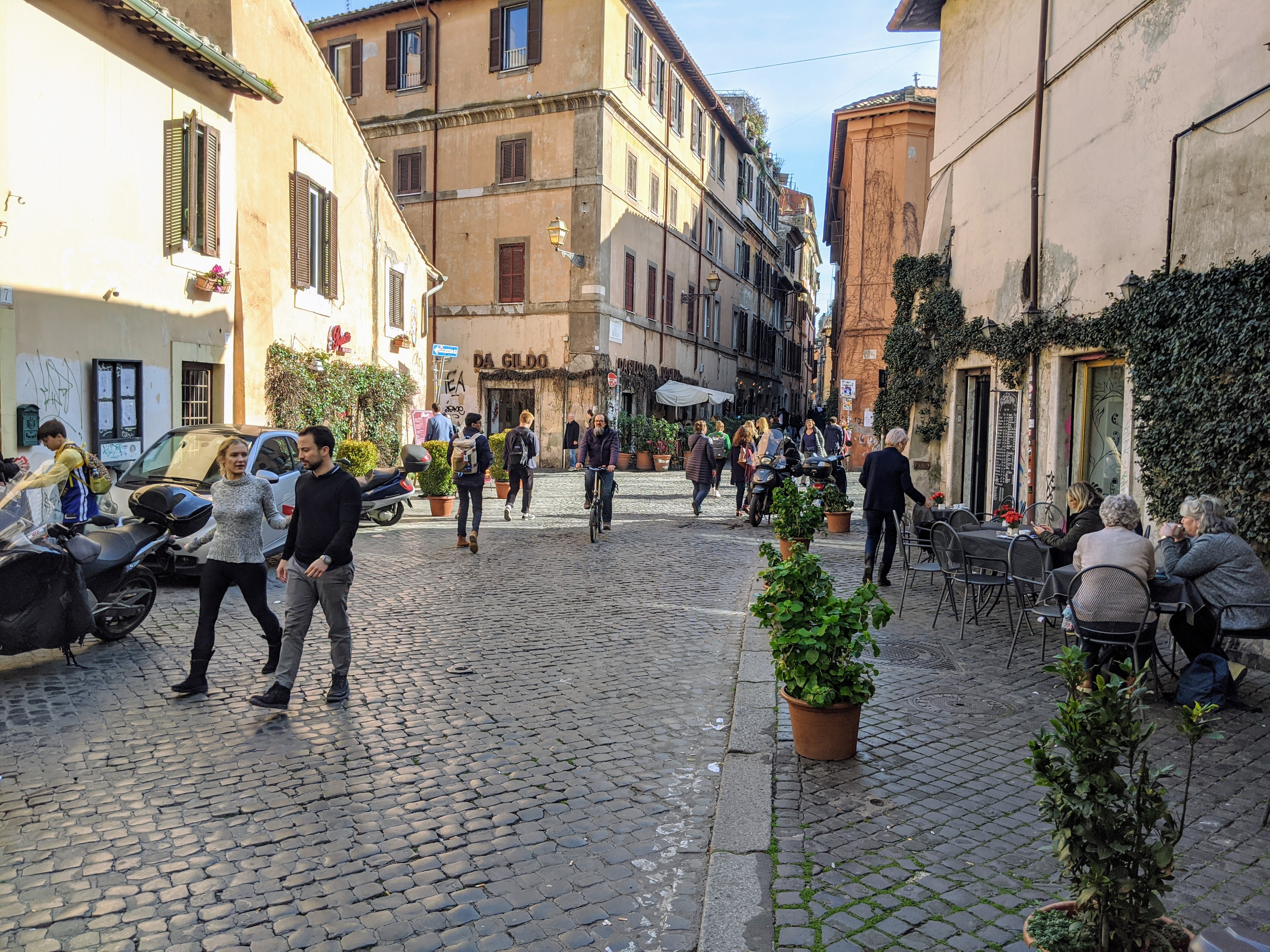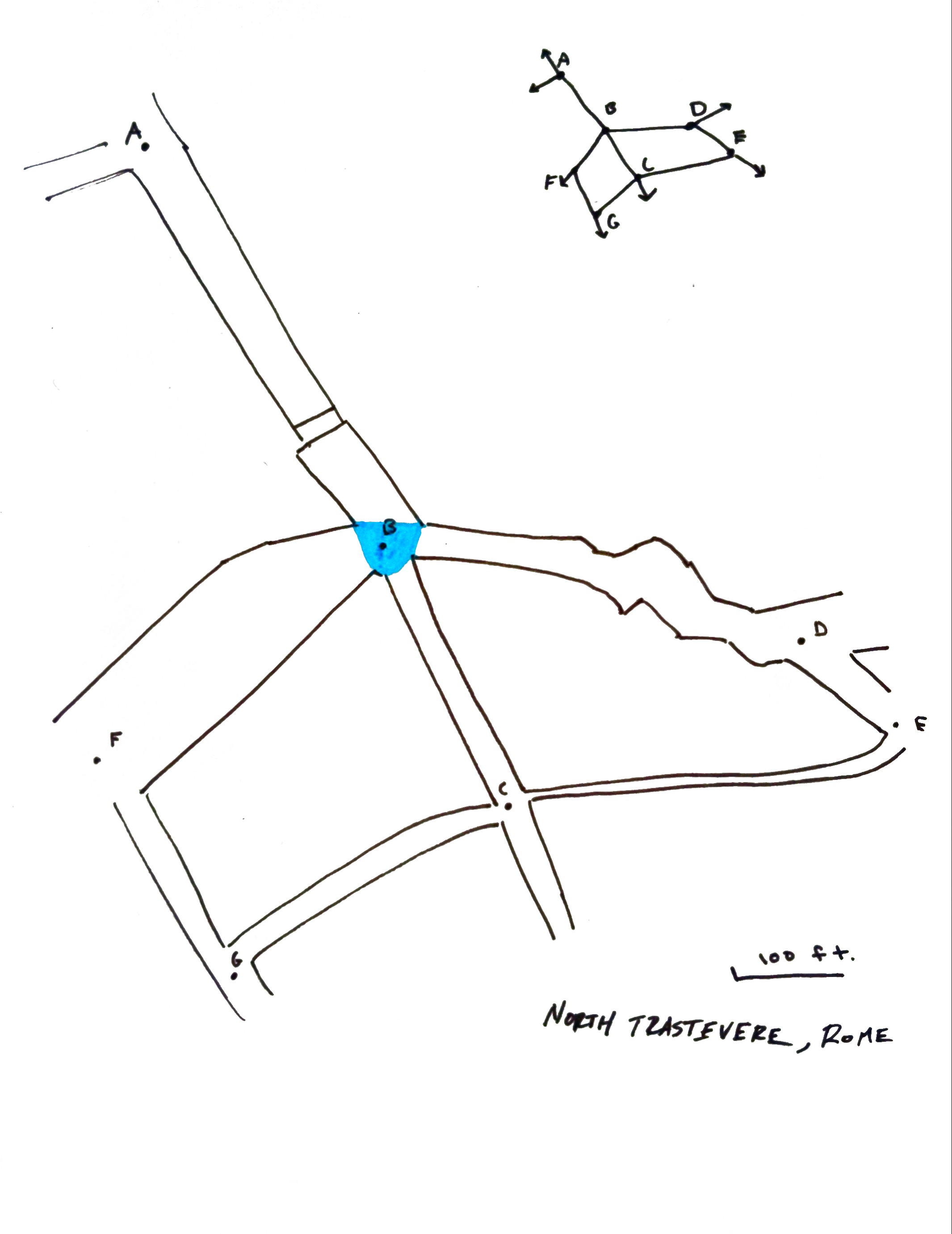Study Abroad Part Two
tags: Study Abroad, Europe
Chaos Theory; Groceries; Oh Won’t You
Welcome back my faithful virtual friends. In this post, I explore a few things mathematical, a few things dogmatical, a few things emblematical, and a few things fanatical… Because!… I am on sabbatical. Ohhh, isn’t rhyming fun? Well, so is being abroad. Enjoy my microcosm of Rome, presented to you via the one and only world wide web.
🌀 Chaos Theory
Walking the streets of Rome are an activity beyond transportation. To get from my apartment to class, I must tiptoe through Trastevere. From the Roman Forum to lunch; stroll along the Tiber. From H&M to the park; strut along pedestrian boulevards —and this is what I am coming to love about this city. You don’t get in a car and zone out for 20 minutes. Instead, you’re forced to interact with the city, smelling food, hearing conversations, and rummaging through streets filled with people of all varieties, leading storied lives.
Okay, so there’s a lot to unpack in the preceding paragraph. But for this week, I want to take a moment to explore a consequence of that last point. As you walk through any city, it is clear that much of the respective complexity comes from the large quantity of people, each pursuing their individual daily actions. Martha goes to get her nails done. Tony goes to school. Cassandra goes to work at the cafe. Luke goes to dinner. And on and on and on. But, in Rome, specifically Trastevere, this complexity can be seen on a more human level than most American cities, where cars dominate the transportation system. For example, there is an intersection in Trastevere which I walk through multiple times a day. It connects one large road and 3 smaller ones, all of which are cobblestone. A café and restaurant occupy the corners, the café being an extremely busy establishment. Each time I walk through this intersection, I am impressed by the quantity of people (and some vehicles) which pass through every minute, seen below.

Intersection of Via di Porta Settimiana, Via di Santa Dorotea, Via Garibaldi and Via della Scala (looking south)\
As I sit at the busy café with my coffee, I see students, newspaper distributers, couples, groups of friends, school children, elderly women and many others, coming from one way and going another. It all seems very chaotic. Every bump, honk and conversation affecting the next minute of activity. This notion of chaos, one of the reason’s I chose to study road-systems for my practicum, is inherently difficult to model. There are so many variables and human decisions in that one intersection, it becomes difficult to imagine blowing the scale up to the entirety of Rome.
Edward Lorenz, a mathematician and meteorologist who worked primarily in the 20th century, was a pioneer in modeling chaos, something which had been an oxymoron for much of the study of mathematics before his time. Through his research with atmospheric modeling equations, he concluded that some systems are very sensitive to initial conditions, such that even a 0.001% change in starting values will completely alter the resulting trajectory of the system. A common example of this is the double-rod pendulum, whose motion is extremely chaotic despite the simplicity of the mechanisms in place. Lorenz also showed that despite chaos, groups of initial conditions can be attracted to central locations, thus birthing his famous Lorenz Attractor graphs, seen below.

Lorenz’s Strange Attractor: Source
Researching chaos theory has opened my eyes to just how we might be able to model road systems. Rome’s road systems are chaotic, but I feel there is an underlying mechanism at play. What the mechanism is, I’m still unsure, but with Lorenz’s ideas in my tool belt, I am initiating a few experimental procedures to further my research:
-
I have set up a GPS logger on my phone. This raw data will be useful to my analyses of using Rome’s road system over long periods of time (3 months)
-
The intersection in Trastevere I spoke of earlier, drawn below, will become my primary data-gathering center during the next few weeks. I really want to investigate what is going one here, and I predict that analyzing one intersection in Rome (which is within my grasp) might reveal hints to the function of the entire city.

The intersection is in blue
Weekly Anecdote: 🛒 Groceries
In a place which is unfamiliar, I find that habitual tendencies help to make it more familiar over time. Thus, I’m not surprised that over the last month, I have formed a habit of making pilgrimage to the grocery store every Monday morning. I don’t have class in the morning, so I can take my time getting up, eating breakfast, and making the journey. But, would I make this the weekly anecdote if there wasn’t a but? Well, here it is… But, last Wednesday was a bit different. I got a late start to the day, so I only had ~1 hour to make the trip before class. After fast-walking there and doing my typical path through the produce, bakery and various isles, I paid and double stepped the stairs back up to the sidewalk (the store is in the basement of a clothing retailer). So there I was with three heavy bags filled with much more that I had intended on getting (a common problem of mine) and only ~20 minutes to make it all the way home and then to class. I knew that with the load, I was not going to be able to walk. But, propped gracefully on their kickstands near the edge of the sidewalk were two red bikes. They were JUMP bikes. I had seen them many times before and vaguely knew that they were rental bikes made by Uber. Luckily, I had downloaded the app knowing that I would, at some point, try one. So, I scanned the QR code on the bike, fumbled with the lock until it came undone, put one bag in the basket and one on either handle, saddled up and put the kickstand in its horizontal position. The next part of this story still makes me chuckle. These JUMP bikes turn out to be partly motorized! So, one turn of the pedal shot me down the sidewalk. Ahhhh! Imagine me, an American guy on a red bike, speeding down the streets of Rome with groceries bags knocking into his knees, swerving around curbs and bumpy cobblestone. I did end up making it home and to class on time… phew.
So, what did I learn from this little adventure? First, riding a bike in Rome is an acquired talent (quite unlike anything I’ve experienced before—it’s more like playing dodgeball than riding a bike). Second, it is usually strenuous circumstances which make us try the craziest things. Third, although scary the first time, Rome’s roads are quite accommodating to multiple means of transportation. And finally, I learned when I do this again, to make sure the eggs are at the top of the bag. Last week Rome’s roads ripped my pants. This week, they cracked a half-dozen eggs—through vibration, yes—but still. Curses.
More on those JUMP bikes next week. I’m intrigued :)
❤️ Oh Won’t You
Oh, Roma… Won’t you sing to me in the moonlight Won’t you call out my name Won’t you mingle in the night Won’t you know your fame
Won’t you share your legions of aroma Won’t you spritz perfume Won’t you take me home-a Won’t you arise from a tomb
Won’t you open of bottle of wine Won’t you fall in love Won’t you build a shrine Won’t you tell me what you’re made of
Won’t you feel the buzz Won’t you give me roses Won’t you do what Santa Maria does Won’t you be what prose is
Oh Roma… Won’t you be my cloud nine Won’t you consider it, please Won’t you be my Valentine Because I’m in love, won’t you see
👋 Until Next Time
Thank you, again, for reading my blog. As I investigate, uncover, and research the essence of this city, I’m finding that Rome has just as much to say about itself as it does about me. Assimilation is more than osmosis… it’s a becoming. Until next time… Ciao!
Well… there was no next time
Unfortunately, in the weeks after I wrote this blog, COVID-19 swept through Italy, and then the world. I had to come home early from my study abroad 😢 But, the time I did have in Europe was *chefs kiss*. In the two weeks prior to flying back to the US, I was able to travel to the UK, exploring London, Edinburgh, and Glasgow. COVID-19 was a shock to all of us—and many people suffered much much more than me. So, I’m not bitter. But, I do have an intense motivation to get back out there and make up the 2 months that I lost… and many more 😄